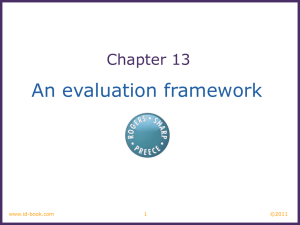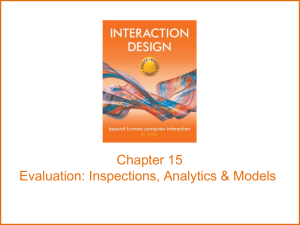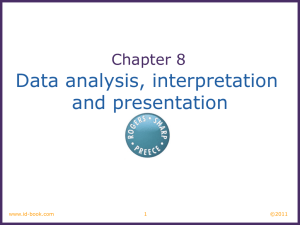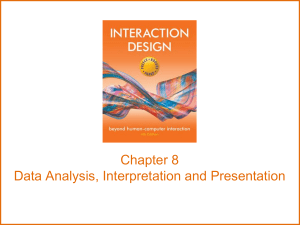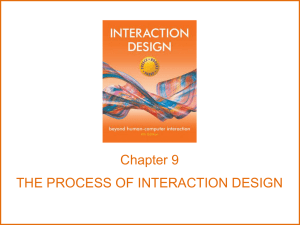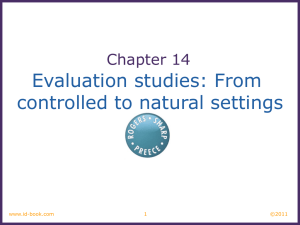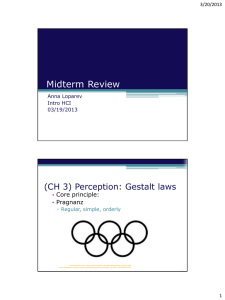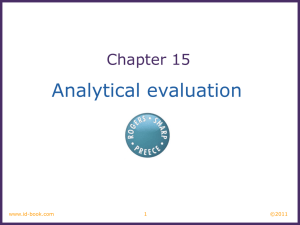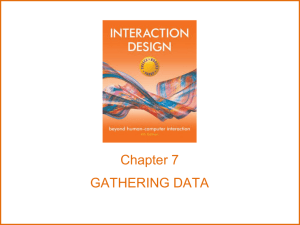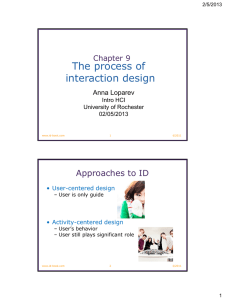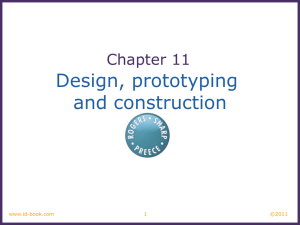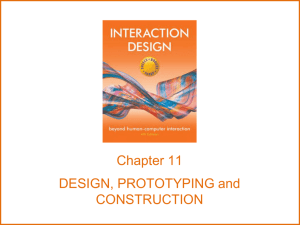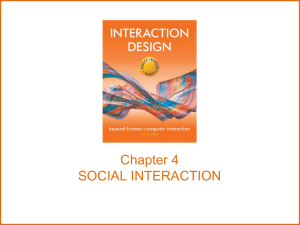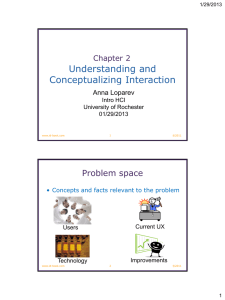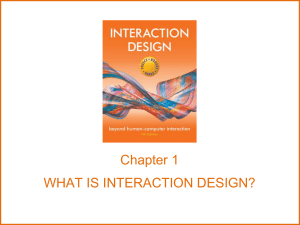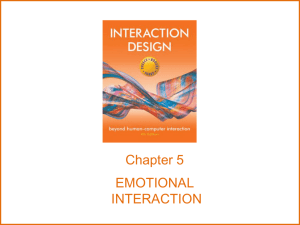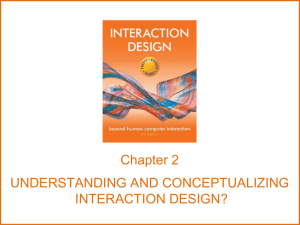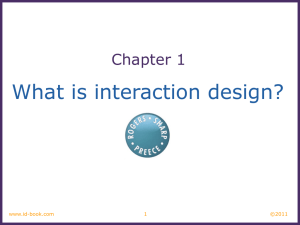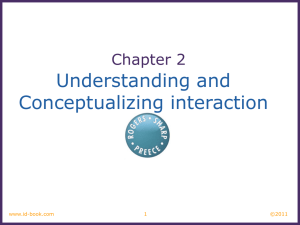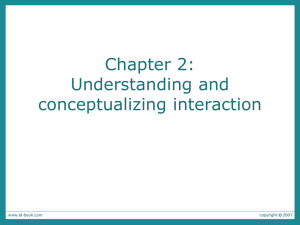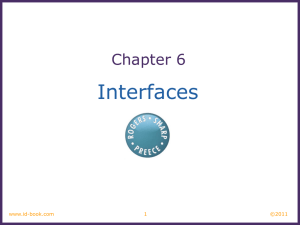Document
advertisement
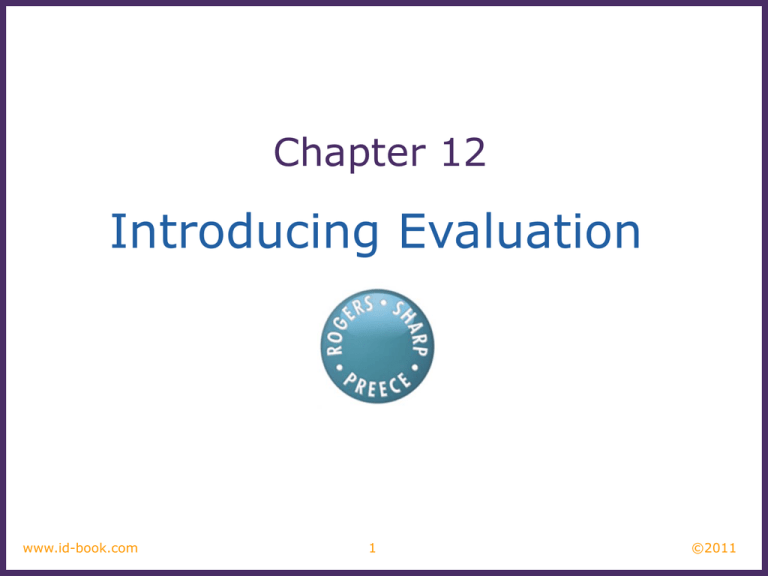
Chapter 12 Introducing Evaluation www.id-book.com 1 ©2011 The aims • Explain the key concepts used in evaluation. • Introduce different evaluation methods. • Show how different methods are used for different purposes at different stages of the design process and in different contexts. • Show how evaluators mix and modify methods. • Discuss the practical challenges • Illustrate how methods discussed in Chapters 7 and 8 are used in evaluation and describe some methods that are specific to evaluation. www.id-book.com 2 ©2011 Why, what, where and when to evaluate • • • • Iterative design & evaluation is a continuous process that examines: Why: to check users’ requirements and that users can use the product and they like it. What: a conceptual model, early prototypes of a new system and later, more complete prototypes. Where: in natural and laboratory settings. When: throughout design; finished products can be evaluated to collect information to inform new products. www.id-book.com 3 ©2011 Bruce Tognazzini tells you why you need to evaluate “Iterative design, with its repeating cycle of design and testing, is the only validated methodology in existence that will consistently produce successful results. If you don’t have user-testing as an integral part of your design process you are going to throw buckets of money down the drain.” See AskTog.com for topical discussions about design and evaluation. www.id-book.com 4 ©2011 Types of evaluation • Controlled settings involving users, eg usability testing & experiments in laboratories and living labs. • Natural settings involving users, eg field studies to see how the product is used in the real world. • Any settings not involving users, eg consultants critique; to predict, analyze & model aspects of the interface analytics. www.id-book.com 5 ©2011 Usability lab http://iat.ubalt.edu/usability_lab/ www.id-book.com 6 ©2011 Living labs • People’s use of technology in their everyday lives can be evaluated in living labs. • Such evaluations are too difficult to do in a usability lab. • Eg the Aware Home was embedded with a complex network of sensors and audio/video recording devices (Abowd et al., 2000). www.id-book.com 7 ©2011 Usability testing & field studies can compliment www.id-book.com 8 ©2011 Evaluation case studies • Experiment to investigate a computer game • In the wild field study of skiers • Crowdsourcing www.id-book.com 9 ©2011 Challenge & engagement in a collaborative immersive game • Physiological measures were used. • Players were more engaged when playing against another person than when playing against a computer. • What precautionary measures did the evaluators take? www.id-book.com 10 ©2011 What does this data tell you? h i gh valu e s indi catemore vari ati on Playing against computer Boring Challenging Easy Engaging Exciting Frustrating Fun Playing against friend Mean St. Dev. Mean St. Dev. 2.3 3.6 2.7 3.8 3.5 2.8 3.9 0.949 1.08 0.823 0.422 0.527 1.14 0.738 1.7 3.9 2.5 4.3 4.1 2.5 4.6 0.949 0.994 0.850 0.675 0.568 0.850 0.699 Source: Mandryk and Inkpen (2004). www.id-book.com 11 ©2011 Why study skiers in the wild ? Jambon et al. (2009) User experience in the wild. In: Proceedings of CHI ’09, ACM Press, New York, p. 4070-4071. www.id-book.com 12 ©2011 e-skiing system components Jambon et al. (2009) User experience in the wild. In: Proceedings of CHI ’09, ACM Press, New York, p. 4072. www.id-book.com 13 ©2011 Crowdsourcing-when might you use it? www.id-book.com 14 ©2011 Evaluating an ambient system • The Hello Wall is a new kind of system that is designed to explore how people react to its presence. • What are the challenges of evaluating systems like this? www.id-book.com 15 ©2011 Evaluation methods Method Controlled Natural settings settings Observing x x Asking users x x x Asking experts Testing x x x Modeling www.id-book.com Without users 16 ©2011 The language of evaluation Analytics In the wild evaluation Analytical evaluation Living laboratory Controlled Predictive evaluation experiment Summative Expert review or crit evaluation Field study Usability laboratory Formative User studies evaluation Usability testing Heuristic evaluation Users or participants www.id-book.com 17 ©2011 Key points Evaluation & design are closely integrated in user-centered design. Some of the same techniques are used in evaluation as for establishing requirements but they are used differently (e.g. observation interviews & questionnaires). Three types of evaluation: laboratory based with users, in the field with users, studies that do not involve users The main methods are: observing, asking users, asking experts, user testing, inspection, and modeling users’ task performance, analytics. Dealing with constraints is an important skill for evaluators to develop. www.id-book.com 18 ©2011 A project for you … • “The Butterfly Ballot: Anatomy of disaster” was written by Bruce Tognazzini, and you can find it by going to AskTog.com and looking through the 2001 column. • Alternatively go directly to: http://www.asktog.com/columns/04 2ButterflyBallot.html www.id-book.com 19 ©2011 A project for you … continued • Read Tog’s account and look at the picture of the ballot card. • Make a similar ballot card for a class election and ask 10 of your friends to vote using the card. After each person has voted ask who they intended to vote for and whether the card was confusing. Note down their comments. • Redesign the card and perform the same test with 10 different people. • Report your findings. www.id-book.com 20 ©2011
